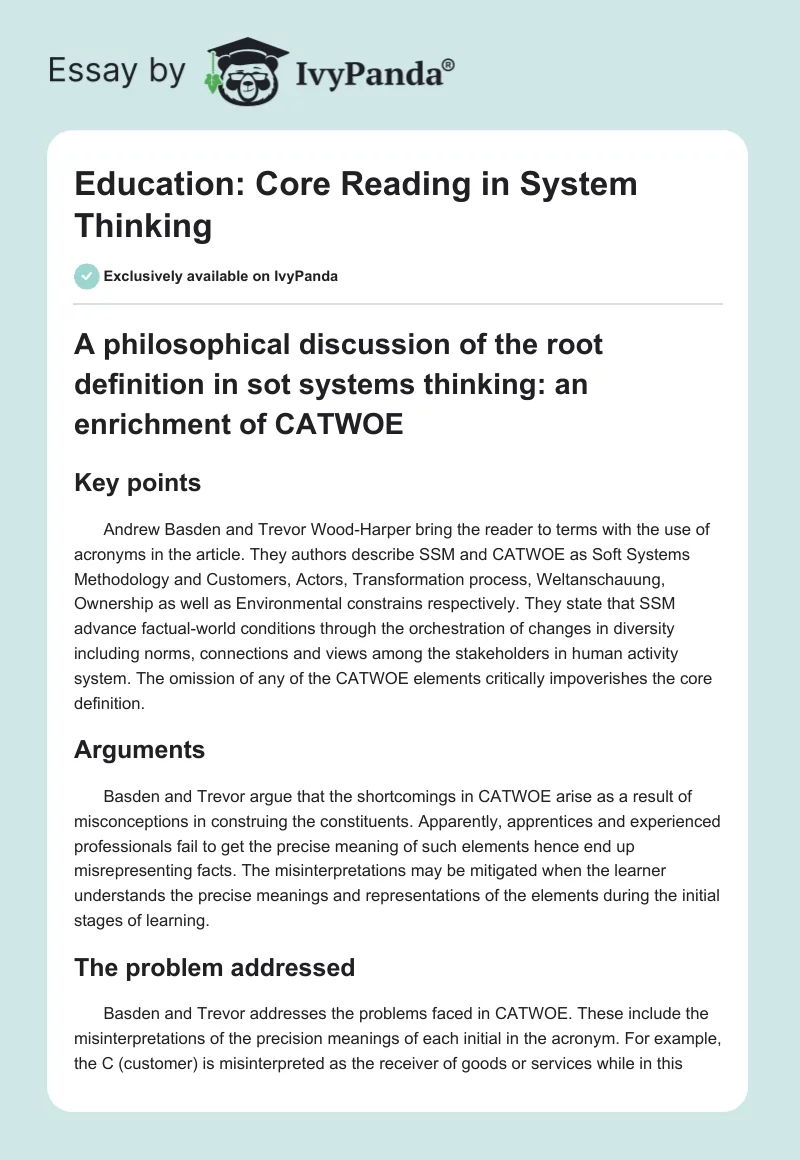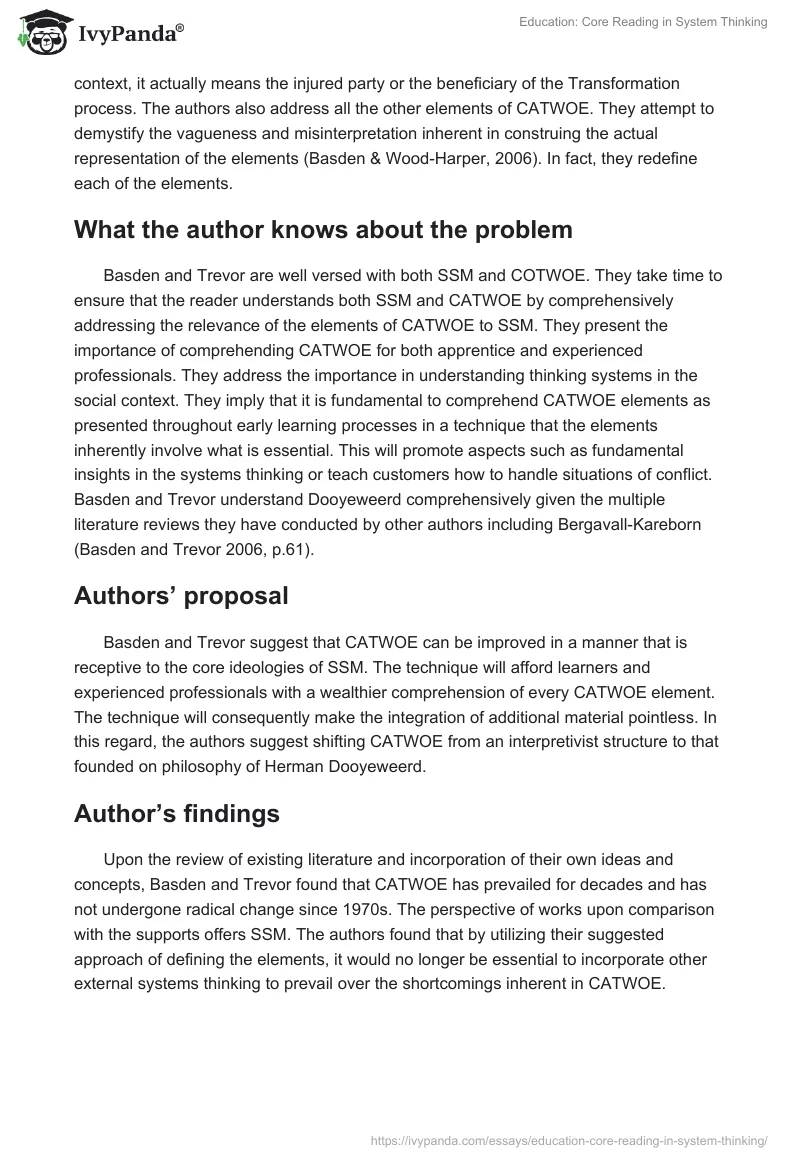A philosophical discussion of the root definition in sot systems thinking: an enrichment of CATWOE
Key points
Andrew Basden and Trevor Wood-Harper bring the reader to terms with the use of acronyms in the article. They authors describe SSM and CATWOE as Soft Systems Methodology and Customers, Actors, Transformation process, Weltanschauung, Ownership as well as Environmental constrains respectively. They state that SSM advance factual-world conditions through the orchestration of changes in diversity including norms, connections and views among the stakeholders in human activity system. The omission of any of the CATWOE elements critically impoverishes the core definition.
Arguments
Basden and Trevor argue that the shortcomings in CATWOE arise as a result of misconceptions in construing the constituents. Apparently, apprentices and experienced professionals fail to get the precise meaning of such elements hence end up misrepresenting facts. The misinterpretations may be mitigated when the learner understands the precise meanings and representations of the elements during the initial stages of learning.
The problem addressed
Basden and Trevor addresses the problems faced in CATWOE. These include the misinterpretations of the precision meanings of each initial in the acronym. For example, the C (customer) is misinterpreted as the receiver of goods or services while in this context, it actually means the injured party or the beneficiary of the Transformation process. The authors also address all the other elements of CATWOE. They attempt to demystify the vagueness and misinterpretation inherent in construing the actual representation of the elements (Basden & Wood-Harper, 2006). In fact, they redefine each of the elements.
What the author knows about the problem
Basden and Trevor are well versed with both SSM and COTWOE. They take time to ensure that the reader understands both SSM and CATWOE by comprehensively addressing the relevance of the elements of CATWOE to SSM. They present the importance of comprehending CATWOE for both apprentice and experienced professionals. They address the importance in understanding thinking systems in the social context. They imply that it is fundamental to comprehend CATWOE elements as presented throughout early learning processes in a technique that the elements inherently involve what is essential. This will promote aspects such as fundamental insights in the systems thinking or teach customers how to handle situations of conflict. Basden and Trevor understand Dooyeweerd comprehensively given the multiple literature reviews they have conducted by other authors including Bergavall-Kareborn (Basden and Trevor 2006, p.61).
Authors’ proposal
Basden and Trevor suggest that CATWOE can be improved in a manner that is receptive to the core ideologies of SSM. The technique will afford learners and experienced professionals with a wealthier comprehension of every CATWOE element. The technique will consequently make the integration of additional material pointless. In this regard, the authors suggest shifting CATWOE from an interpretivist structure to that founded on philosophy of Herman Dooyeweerd.
Author’s findings
Upon the review of existing literature and incorporation of their own ideas and concepts, Basden and Trevor found that CATWOE has prevailed for decades and has not undergone radical change since 1970s. The perspective of works upon comparison with the supports offers SSM. The authors found that by utilizing their suggested approach of defining the elements, it would no longer be essential to incorporate other external systems thinking to prevail over the shortcomings inherent in CATWOE.
Author’s conclusion
Basden and Trevor concluded that Dooyeweerd thinking was ahead of his time since it entailed characteristics that are essential in the modern life world. It recognized the diversity and rationality while centering on the meaning as opposed to existence. It acknowledged the essential role of liberated and accountable human functioning making it proportional to the spirit of SSM.
Application of soft systems methodology to the real world process of teaching and learning
Key points
Nandish Patel indicates that Soft Systems Methodology (SSM) offers a methodical and prearranged perspective or the analysis of human action systems including educational organizations. Although the methodology has been extensively applied and developed by Lancaster University engineers and technology experts to solve challenges regarding efficiency and efficacy, it is widely applied in other fields that do not necessarily involve technological organizations. SSM is important in addressing the learning needs of learners with the aim of meeting and satisfying them. There are diverse problems that are faced by educational institutions and they require urgent attention to facilitate effective learning and teaching in the parts of learners and teachers respectively.
Arguments
Patel argues that SSM has the capacity to deal with all areas of focused human activity. It is applicable for problems that can be analyzed precisely and appropriate resolution found (hard problems) as well as those that cannot be formulated or pointed out precisely (soft problems). The author asserts that the SSM is distinctive as it allows the analyst to concentrate on a course of learning regarding real world circumstances under investigation while at the same time finding ways for improvement of the situation within the model of soft systems (Patel, 1995).
The problem addressed
Patel sought to illustrate the importance of SSM in finding solutions for problems that demand attention and amicable solution found and implemented. Although the author identifies two sets of problems namely hard and soft, he is interested in applying SSM in resolving ‘soft’ problems in education systems particularly the teaching and learning processes. In this regard, the author analyzes the teaching and learning process through the application of SSM to demonstrate the importance of the methodology in conceptualizing human activity system in the education field.
What the author knows about the problem
Patel states that the analysis is entirely based on scholarly and empirical comprehension of the teaching and learning process. Based on this assertion, the author continues to assert that knowledge possessed will generate insights into the improvement of the teaching and learning process.
Author’s proposal
Patel proposes the implementation of SSM in educational institutions (Patel, 1995). The proposal arises from the fact that while it is essential for learners to attain the highest educational achievements, it is also important for them to enjoy the learning process through which they attain the desired degree of classification. The application of SSM according to the author would assist in establishing whether systems thinking practitioners could point out the hindrances to the satisfaction of learners’ needs or not.
Author’s findings
Patel found diverse issues that have not been previously recognized or practiced in conducting teaching and learning processes. The author states that the research conducted in the study has revealed that the teaching and learning process can be significantly improved through the application of SSM as it allows the analysis of real world situations of concern (Patel, 1995).
Author’s conclusion
Patel concludes that SSM approach in analyzing real world circumstances is essential in the education field practice. Since the study conducted by Patel reveals that SSM is relevant in educational systems, it is imperative or other researchers should consider other fields in educational systems where the methodology can be applied with effectiveness. The approach is applicable when the need is to analyze and improve specific areas of the processes of education.
References
Basden, A & Wood-Harper, T 2006, ‘A philosophical discussion of the root definition in sot systems thinking: an enrichment of CATWOE,’ Systems Research, vol. 23 no. 1, pp. 61-87.
Patel, N 1995, ‘Application of soft systems methodology to the real world process of teaching and learning,’ International Journal of Educational Management, vol. 9 no. 1, pp. 13-23.


